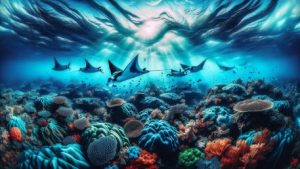Capturing the Deep Blue: Essential Underwater Photography Tips for Exploring Palau’s Marine Wonders
Embarking on an underwater journey to photograph the pristine marine life in Palau can be both thrilling and challenging. With its crystal-clear waters and vibrant coral reefs, Palau offers a unique opportunity for divers and photographers to capture a world teeming with color and life. In this blog post, we’ll dive into the essential tips to help you bring out the best in your underwater photography, ensuring you take home memories as vivid as the waters of this Pacific paradise.
Understanding Your Equipment
Before you plunge into the depths, it’s crucial to acquaint yourself with the equipment you’ll be using. A waterproof camera or underwater housing for your DSLR is a must-have, but knowing how to use it in aquatic conditions is what makes the difference. Here are some key points:
- Ensure your camera housing has no leaks and is rated for the depths you plan to explore.
- Practice using your camera in the housing while on dry land to become familiar with the controls.
- Invest in a quality strobe or underwater flash to combat the loss of colors as you descend.
Mastering Lighting and Composition
Light behaves differently underwater, and mastering its nuances is essential for stunning photographs. Composition also plays a significant role in the visual impact of your shots.
Lighting Techniques
Underwater, colors can quickly fade as you go deeper. To retain the vibrant hues of marine life, you’ll need to master lighting:
- Use external lights or flash to restore the natural colors of your subject.
- Adjust your white balance settings manually for accuracy.
- National Geographic suggests taking advantage of natural sunlight whenever possible by shooting upwards towards the surface.
Composition Tips
Good composition is the backbone of any great photograph. Here are some composition tips for underwater photography:
- Follow the Rule of Thirds to create a balanced and engaging frame.
- Isolate your subject by getting close and using a shallow depth of field.
- Look for contrasting colors or patterns to make your subject stand out.
Respect Palau’s Marine Life
Palau is not only a haven for photographers but also an ecological treasure that needs protection. While capturing its beauty:
- Avoid touching or disturbing the coral reefs and marine creatures.
- Be mindful of your buoyancy and avoid stirring up sediment which can ruin your shot and harm the ecosystem.
- Learn from experienced guides, such as those from Palau Explorer, who can help you find the best spots while respecting the natural habitat.
Post-Processing Your Underwater Images
Post-processing is where you can fine-tune your images to reflect the true beauty of your underwater experience. Software like Adobe Lightroom or Photoshop can be invaluable:
- Adjust the contrast and saturation to bring out the colors that are often muted underwater.
- Crop and straighten your photos for the perfect composition.
- Remove any unwanted particles or backscatter caused by suspended sediment.
With these tips in hand, you’re well on your way to capturing the underwater magic of Palau. Remember that patience and practice are key to any form of photography, especially in the dynamic environment beneath the waves. So, gear up, dive in, and ready your camera to explore and immortalize the wondrous marine life of Palau. Happy shooting!
FAQs
What type of underwater camera is best for shooting in Palau – DSLR or GoPro?
While GoPros offer great portability, a mirrorless or DSLR camera will provide the highest quality photos and better control. But pack a strobe light too since sunlight fades as you dive deeper observing marine life.
What underwater accessories enhance Palau diving photography?
We recommend packing a durable housing protecting camera electronics, wide angle lens capturing big animals that pass closely by up near, plus powerful external strobes/flash diffusers evenly lighting creatures lurking deep inside rocky crags and overhangs.
How should I prepare camera equipment for these saltwater environments beforehand?
Check O-rings seals integrity on any housing ensuring no leaks damage delicate gear, fully charge batteries maximizing runtimes under, and pack quality silicone grease/wipes protecting lens from fogging after rapid temperature changes emerging from tropical waters between shoots.
Which underwater photography techniques work best in Palau?
Use slower shutter speeds freezing motion as squid jet by or bump camera ISO levels boosting light sensitivity when strobes insufficiently penetrate denser blue-green depths and shadowy outcroppings losing ambient sunlight. Also approach marine subjects cautiously avoiding damage fragile habitats get near perfect capture angles at their comfort.
What rules govern underwater photography to prevent disrupting local marine life?
Palau enforces strict wildlife harassment policies with steep fines against divers stressfully chasing unique species like sea turtles disrupting natural behaviors for capture, destroying fragile coral structures positioning unique selfies or removing live specimens like clams sidestepping future preservation. Simply respect underwater subjects and environments while shooting responsibly please.
Which marine species make great photographed centerpiece subjects around Palau islands and dive sites?
Photographers highly recommend emphasizing endemic marine biodiversity like giant Napoleon wrasse frequenting sandy cleaning stations plus bright nudibranch sea slugs, luminous spotted cuttlefish or camouflaged mandarin fish pairs guarding eggs below overhangs offer super photogenic options worth highlighting vacation slideshows later undoubtedly! Just avoid crowding into dens disturbing delicate breeding rituals respectfully admiring their alluring beauty and colors.
